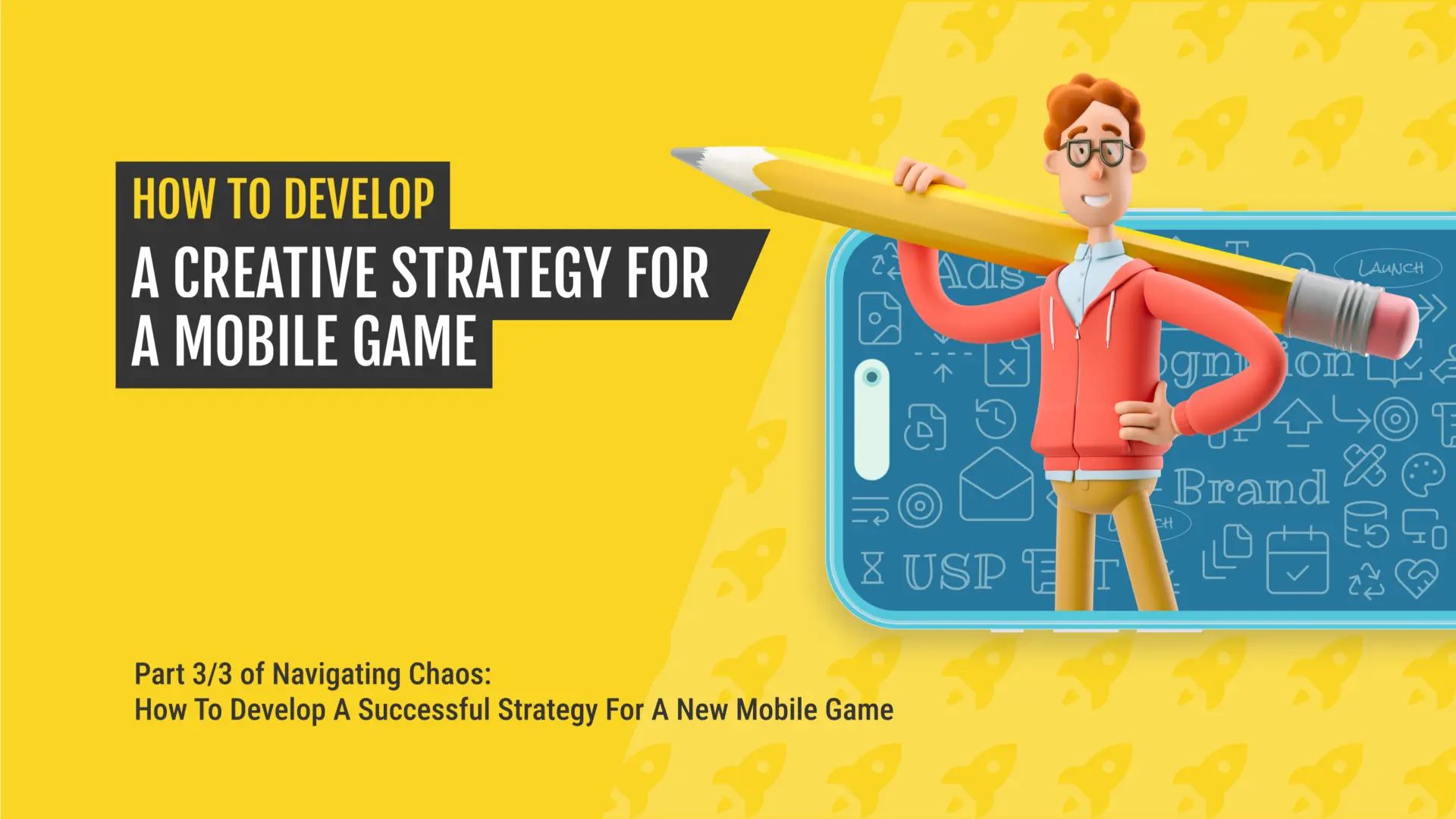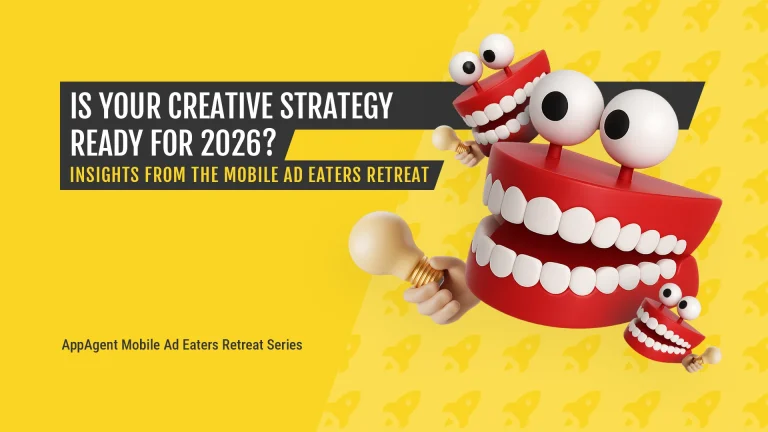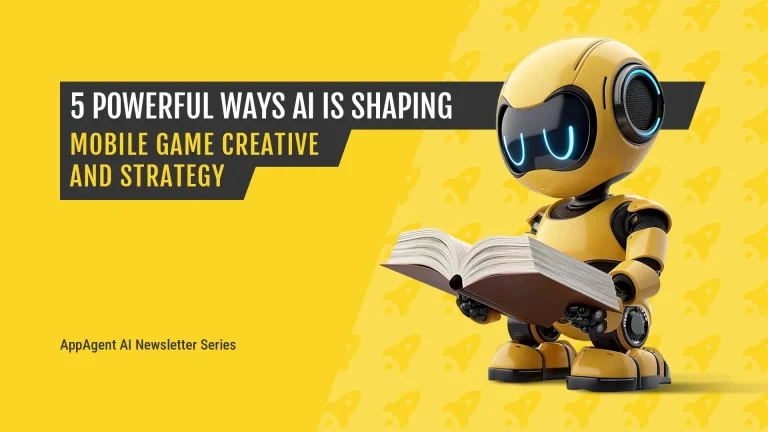Welcome to Part Three of the Navigating Chaos Series! Over the course of three articles, we’ll provide you with practical tips for developing a successful strategy for a mobile gaming studio.
Subscribe to our newsletter to be notified when the next article is published!
In Part One of this series, we emphasized that the primary focus when deciding what games to develop should be the audience. The design and mechanics of new games should be built upon a solid, pre-existing understanding of the target groups and their preferences.
In the second installment, we explored how critical it is to achieve low CPIs by utilizing creative strategy and marketability testing.
But what exactly is a creative strategy, how do you build one, and how do you achieve the “sex appeal” of your game?
That’s exactly what this third and final part of the series will cover.
What is a Creative Strategy and How is it Created?
A creative strategy is a plan that outlines the best ways to communicate a message or brand to attract and engage an audience.
It also defines the key message and the execution approach—essentially determining the final look and feel of the game’s key visual.
Think of the key visual as a “poster,” a condensed representation of the game. It typically showcases main characters in a specific art style and tonality within the game environment, and it may even include a tagline or slogan.
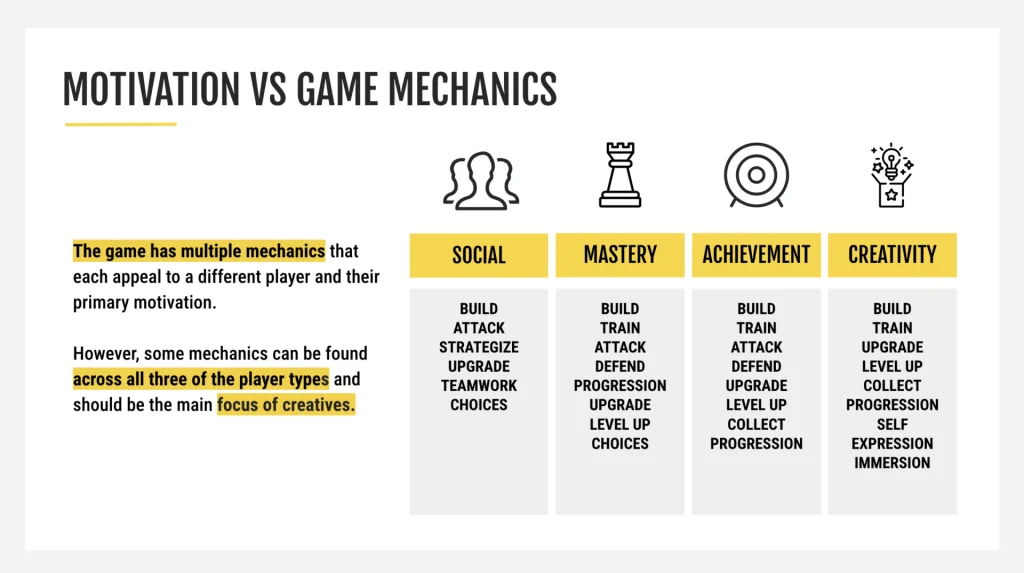
Developing a creative strategy for mobile game involves balancing several key elements: keeping your audience in mind, understanding their motivators (and what they are willing to pay for), agreeing on a Unique Selling Proposition (USP) and brand identity, and experimenting within these boundaries.
Eve Chang, who has led teams at Imangi Studios and PopCam Games before transitioning to freelance work, highlights the importance of a strategic approach: “Everybody has an opinion; you need to have a cohesive voice.”
Key Components of a Solid Creative Strategy
A solid creative strategy for a mobile game should include:
- An analysis of past creatives and store experiments, along with the main takeaways
- A competitor snapshot that focuses on identifying successful patterns
- Audience research that outlines player archetypes, their motivators, and their feedback about the game
- Specific mid-term objectives of the creative strategy, typically spanning the next 3-6 months
- Key communication message(s)
- Multiple creative directions to explore
- A balance between copies of direct competitors, iterations, original creatives, and experimental creatives (which can take inspiration from current trends, cultural phenomena, or simply your intuition)

In agencies or large companies, creative strategy is developed by a specialized creative strategist who can combine key market insights, product design, and communication strategy into a functional whole.
In gaming teams, however, such a role is still rather rare and is usually being supplanted by an art director or marketing creative director.
Creative Strategy for mobile game Goes Beyond Marketing
A creative strategy sets boundaries between what to test and not to test. Still, there’s plenty of space for how the game will be “packaged” and promoted. Will it be a humorous cartoony title with goofy characters or a dramatic, mysterious, and even a bit scary experience?
When you begin marketing a new game, you can test and measure what attracts and resonates with the most valuable players. The most effective creative direction should then not only be applied to future communications but also to shape the product itself. This ensures that the user is not abruptly confronted with a different game than what was originally promised.
Developing a creative strategy for mobile game isn’t a one-off activity, but rather an iterative exploration of different avenues with the target audience and desired originality of the game in mind.
Eve Chang conducts regular planning meetings regarding what new data needs to be collected and how to design experiments to collect new learnings:
“Stay agile and make sure data verifies your decisions. Is the problem in the quality of advertising, is it the product messaging, or the product itself? Don’t guess, ask the data!”
Paula Neves then revisits her long-term strategy based on fresh insights regularly, and for new games even quarterly.
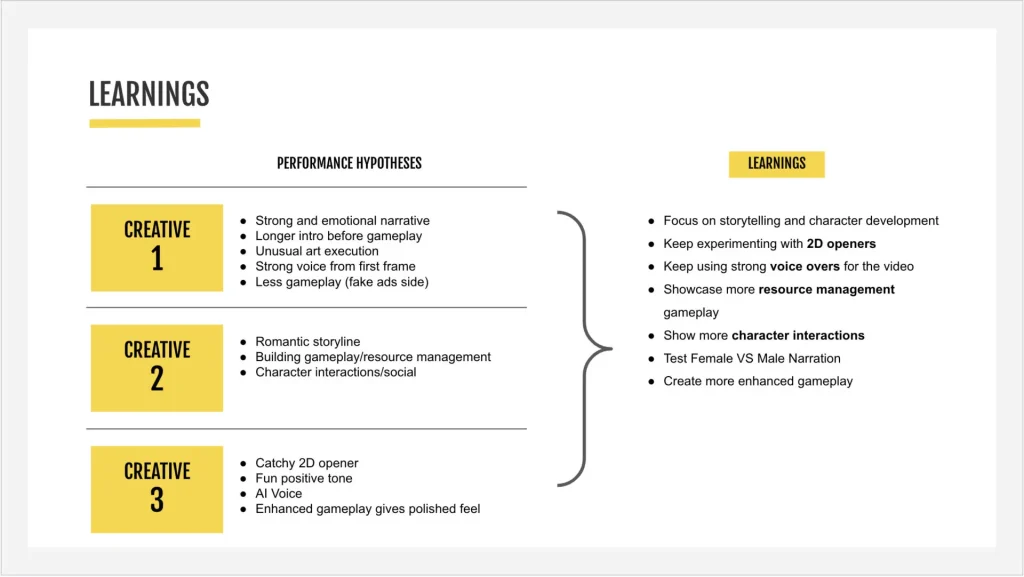
It’s fair to say that building a brand doesn’t make sense for a lot of games, and even entire gaming categories (just think of hypercasual). Becoming an established IP is expensive and a very long-term endeavor.
Ritva Eskelinen shares her perspective: “It’s a big investment and commitment so it makes sense to pursue if the product requires that and will benefit from it.”
The Recipe for Developing a Creative Strategy
When it comes to developing a creative strategy for mobile game, where do you begin?
Mike Lee, an experienced Product Marketing Manager whom I met for the first time at Glu Mobile back in 2019 and currently at Jam City, has a recipe for this:
“I center the creative process around new user UA campaign objectives (monetization) and what those players pay for in their first-time user experience. Those motivations become the central pillar of creative communication when briefing and aligning internal and external stakeholders.”
To enhance communication and messaging strategy, Mike allows inspiration to come to him both intentionally and unintentionally:
“Part of being a creative is keeping up with competitive and relevant trends through Sensor Tower/Data.AI. I’ll often ask myself why was this creative made? Who is this for? How does this potentially fit our competitor’s UA strategy and is it applicable to our strategy?
Viewing ads with context is key. For non-work related content, it’s important to pay attention to cultural moments and trends on social media. Even traditional media that can resonate with a broader audience beyond just mobile gaming. Media consumption should be viewed through a contextual lens.”

The Role of a Unique Selling Proposition (USP)
These two inputs–what people pay for and what you can learn from the competition–are then translated into a unique selling proposition. This USP needs to be present in all marketing creatives. Experimentation is around the form but that USP must always be there!
By doing so, you can achieve consistent communication over time and across different touchpoints. This is important to maximize user conversion and decrease your acquisition costs.
“My creative briefs often reference both visual examples and the user motivations behind what we want our creatives to achieve. These become the building blocks and ingredients an artist can use to create their own remix of an existing concept. This addresses the What, How, and Why of a creative,” Mike continues.
So what makes a great creative?
Great creatives include a visual language that people are familiar with–like a current TikTok trend–but with a twist. Think of it like a popular music track built upon an existing melody, but with its unique spin on it.
“It’s important for ad to be easily recognizable upfront and offer a holistic ad experience that’s novel. The audience needs to easily digest the information, but offers a new twist or kick to the flavor of the ad to trigger curiosity and action”. Mike closes our chat in the lobby of LinkedIn’s San Francisco office.
Refreshing your Creative Strategy in the Later Stages
The need to refresh your creative strategy may come even years after the game is out on the market.
From our experience, here are five signs that it may be time for an overhaul:
- No execution of creatives brings significant uplift.
- The top of the funnel deteriorated, while in-game retention and monetization showed good performance.
- There’s new competition on the market that attracts a similar audience.
- The creative theme has become outdated over time.
- The product has changed over the years, and communication is not properly reflecting this evolution.
AppAgent joined such projects at later stages of soft launch. In some instances, we even worked on established games that experienced a decline in player interest.
The first vital step is to define the goal of the revamp. Secondly, consider how deep the creative strategy revamp can go. Is it primarily focused on crafting a narrative for UA purposes? Are we considering changes to the game’s art style, or is it something in between? This discussion is essential to have.
If the product exhibits strong retention data, it typically indicates that the issue lies at the top of the funnel. In such cases, we focus on finding fresh creative solutions that remain true to the essence of the game.
However, if the numbers reveal a decline in early retention, it suggests potential issues with the ads-store-FTUE link or that the theme and appearance may be outdated. In the worst-case scenario, when data demonstrate a worsening trend in D3-D30 retention over time, it may indicate that the current audience has been exhausted or that the product is no longer relevant.
In such situations, creative strategy and testing may necessitate a more significant overhaul of the product itself.
A Creative Strategy Revamp Can Be a Turning Point
Futureplay, for example, did exactly that and broke free from their performance plateau. Mari Losonnen, the Creative Producer at the Finnish studio, shared how big an effort it was:
“The rebranding of Merge Gardens was 18 months of work. We had a long-term vision about the game positioning but reacted a lot to many tests before rolling the rebrand out.”
For Futureplay, the result was a remarkable increase in downloads by 1000%, a doubling of player retention, and achieving a top 100 grossing position on Android in the US. Not bad for a game that was nearly defunct in 2022…

Key Takeaways From Part Three
- Creative strategy development is a process that typically spans from a few months to over a year.
- Establishing a unique selling proposition and brand helps set healthy boundaries to achieve consistent communications.
- Just like games themselves, the most effective ads blend familiarity with a twist.
Final Thoughts
The goal of this series was to address frequent questions from AppAgent’s clients as well as my own inquiries about the right approach for designing and communicating a game with the potential to thrive in the post-IDFA era.
I want to prove that blindly replicating products and ads is either nonsensical or a short-term solution. Success begins with identifying your audience and their preferences and carving out your own space and USP.
Then, systematically crafting a creative strategy that attracts payers (not a typo, really payers) for the lowest possible price enables you to buy time to increase LTV and guide your studio onto a sustainable path.
All of the interviews included in this series proved that tension between long-term thinking and short-term testing exists and is, in fact, necessary. Yet successful companies have established systems and sets of rules for balancing these two aspects—avoiding being overly rigid or reactive.
Curious to hear your thoughts and comments.
And if you’re looking for strategic help to acquire high-value users and grow your business, drop me a message.
